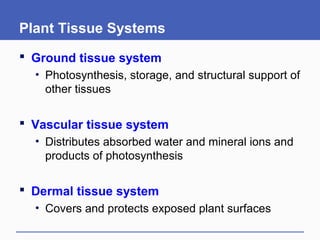
Plant org lab tz
- 1. Plant Tissue Systems Ground tissue system • Photosynthesis, storage, and structural support of other tissues Vascular tissue system • Distributes absorbed water and mineral ions and products of photosynthesis Dermal tissue system • Covers and protects exposed plant surfaces
- 2. Body Plan: Tomato Plant •Shoot system: above ground •Stems, leaves, flowers •Root system: below ground
- 3. Apical and Lateral Meristems •Apical meristem: located at tips of shoots and roots •Primary growth •Lengthening •Lots of mitosis •Lateral meristem: secondary growth •Thickening
- 4. Vascular Tissues •Xylem: transports water •Two cell types: tracheids and vessel elements •Hollow, nonliving •Phloem: transports sugars •Cells called sieve tubes •Living
- 5. Dermal Tissues Epidermis • Usually a single outer layer of cells that secrete a waxy, protective cuticle • May contain specialized cells that form stomata for gas exchange
- 6. Eudicots and Monocots Flowering plants are divided into two classes with tissues organized into different patterns Eudicots have two cotyledons (seed leaves) • Netlike leaf veins • Floral parts in multiples of 4 and 5 Monocots have one cotyledon • Parallel leaf veins • Floral parts in multiples of 3
- 7. Inside the Stem Vascular bundles • Multistranded cords of vascular tissues threaded lengthwise through ground tissues of all shoots Two distinct patterns of vascular bundles • Eudicot stems: Cylinders run parallel with stem, divide ground tissue into cortex and pith • Monocot stems: Bundles distributed throughout ground tissue
- 8. Root Structures Divided into four general regions • Root Cap: protects root as it lengthens • Region of Cell Division: apical meristem • Region of Elongation: cells lengthen and widen • Region of Maturation: mature cells differentiate into different types •Root hairs: increase the surface area for water and nutrient uptake •Derived from epidermis
- 9. Internal Root Structures Epidermis: covers exposed surfaces Cortex: cells adjacent to the epidermis • Used for food storage Vascular tissues: xylem and phloem • Form the vascular cylinder Endodermis: single cell layer around the vascular tissues • Aids in mineral/water exchange Pericycle: undifferentiated cells • Source of new lateral roots
- 10. Eudicot and Monocot Root Structures You will look at cross section slides of a monocot and a eudicot root. Notice the star shape xylem and phloem in between the points on the eudicot Look for the pith in the monocot, used for food storage.
- 11. Root Systems Taproot Fibrous root
- 12. Modified Stems Many plants have modified stem structures that function in storage or reproduction • Stolons (reproductive runners) • Rhizomes (main underground storage stems) • Bulbs (layered underground stems) • Corms (solid underground storage stems) • Tubers (stolons thickened for storage)
- 13. Leaf Shapes •Simple leaf: single blade •Compound leaf: blade with leaflets •Palmately: leaflets attached at one point •Pinnately: leaflets attached at intervals
- 14. Leaf Structure •Epidermis: outermost layer of cells •Lower and upper •Cuticle: waxy, protect, conserve H2O •Palisade mesophyll: upper, many chloroplasts •Spongy mesophyll: lower, air spaces •Stomata: openings for gas exchange •Guard cells: surround stomata and control
- 15. Vein Patterns in Flowering Plants
Editor's Notes
- Figure 1: Tomato plant. Author: OpenStax College. Organization: Rice University, OpenStax. http://cnx.org/contents/185cbf87-c72e-48f5-b51e-f14f21b5eabd@9.85:157/Biology. CC-BY 3.0
- Apical meristem (Meristemo apical). Author: Luis Fernandez Garcia. Organization: Wikimedia. https://commons.wikimedia.org/wiki/File:Meristemo_apical_2.jpg. CC-BY-SA 2.5 Spain An optical micrograph of a root tip. Author: Clematis. Organization: Wikimedia. https://commons.wikimedia.org/wiki/File:Root_tip.JPG . CC-BY-SA
- Diagram of xylem tissue in plants. Author: Kelvinsong. Organization: Wikimedia. https://commons.wikimedia.org/wiki/File:Xylem_cells.svg. CC-BY-SA 3.0. Diagram of phloem tissue in plants. Author: Kelvinsong. Organization: Wikimedia. https://upload.wikimedia.org/wikipedia/commons/thumb/e/e2/Phloem_cells.svg/2000px-Phloem_cells.svg.png. CC-BY-SA 3.0
- Figure 6: Dicot and Monocot Stem cross-section. Author: OpenStax College. Organization: Rice University, OpenStax. http://cnx.org/contents/185cbf87-c72e-48f5-b51e-f14f21b5eabd@9.85:158/Biology. CC-BY 3.0
- Figure 2: A longitudinal root view. Author: OpenStax College. Organization: Rice University, OpenStax. http://cnx.org/contents/185cbf87-c72e-48f5-b51e-f14f21b5eabd@9.85:159/Biology. CC-BY 3.0
- Root-tip, showing root-cap and hairs. Author: Unknown. Organization: Wikimedia. https://commons.wikimedia.org/wiki/File:LA2-NSRW-4-0140.jpg. Public Domain.
- Figure 4: Typical Dicot and Monocot Roots. Author: OpenStax College. Organization: Rice University, OpenStax. CC-BY 3.0
- Leucaena leucocephala. Author: Forest and Kim Starr. Organization: hear.org. https://commons.wikimedia.org/wiki/File:Starr_070404-6562_Leucaena_leucocephala.jpg. CC-BY 3.0 Royal Palm Root System. Author: Kumar 83. Organization: Wikimedia. https://commons.wikimedia.org/wiki/File:Royal_Palm_Roots.jpg. CC-BY-SA 3.0
- Figure 1: Single leaf Structure. Author: OpenStax College. Organization: Rice University, OpenStax. http://cnx.org/contents/185cbf87-c72e-48f5-b51e-f14f21b5eabd@9.85:160/Biology. CC-BY 3.0 Opposite Leaves. Author: Eric Guinther (Marshman). Organization: Wikimedia. https://commons.wikimedia.org/wiki/File:Leaves_opposite.jpg. CC-BY-SA 3.0
- The fine scale structure of a leaf featuring the major tissues. Author: Zephyris. Organization: Wikimedia. https://en.wikipedia.org/wiki/File:Leaf_Tissue_Structure.svg. CC-BY-SA 3.0
- The parallel veins of iris leaves. Author: Drewboy64. Organization: Wikimedia. https://en.wikipedia.org/wiki/File:Tulip_Leaves_AWL.JPG. CC-BY 3.0 A leaf. Author: Jon Sullivan. Organization: Wikimedia. https://commons.wikimedia.org/wiki/File:Leaf_1_web.jpg. Public domain.
